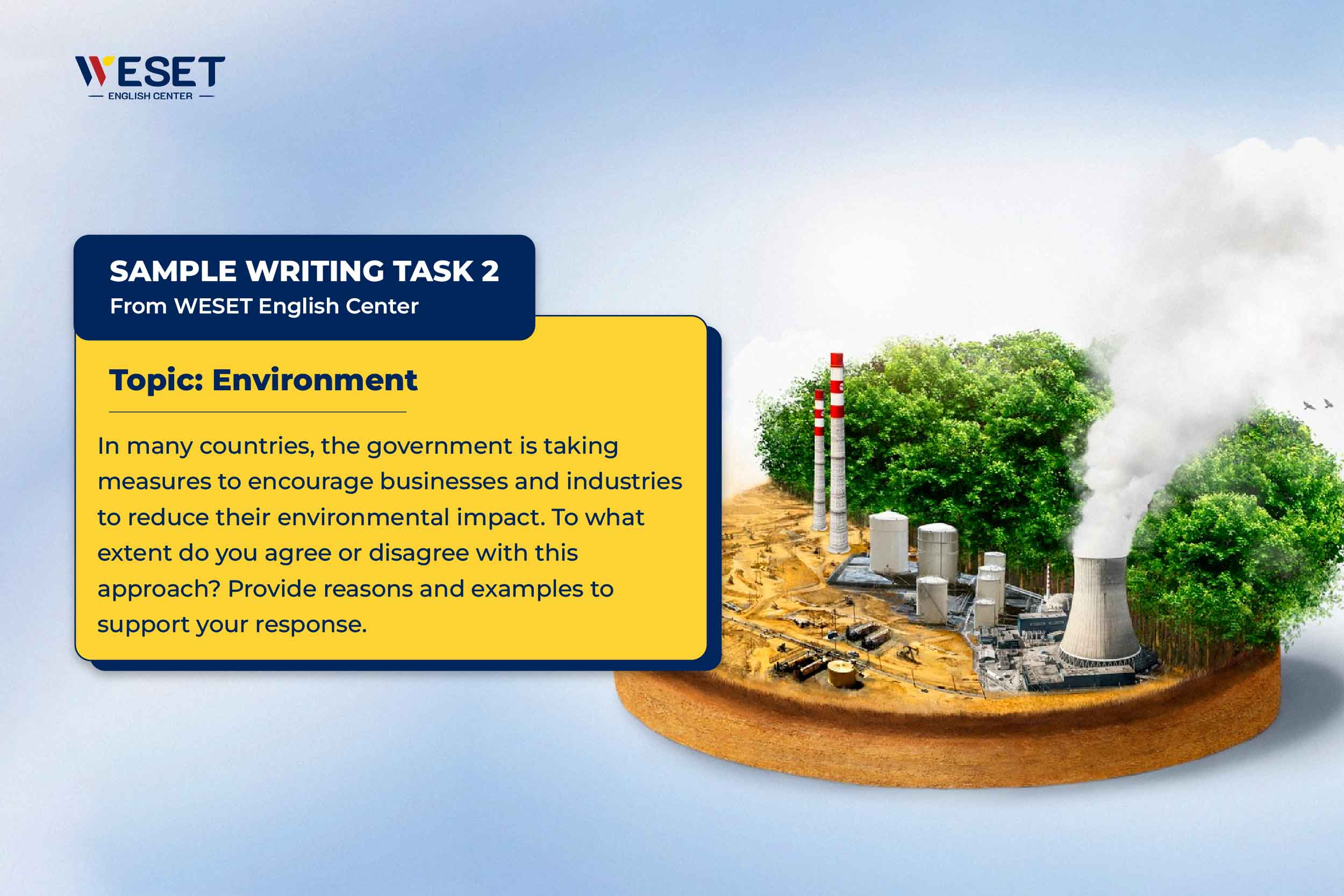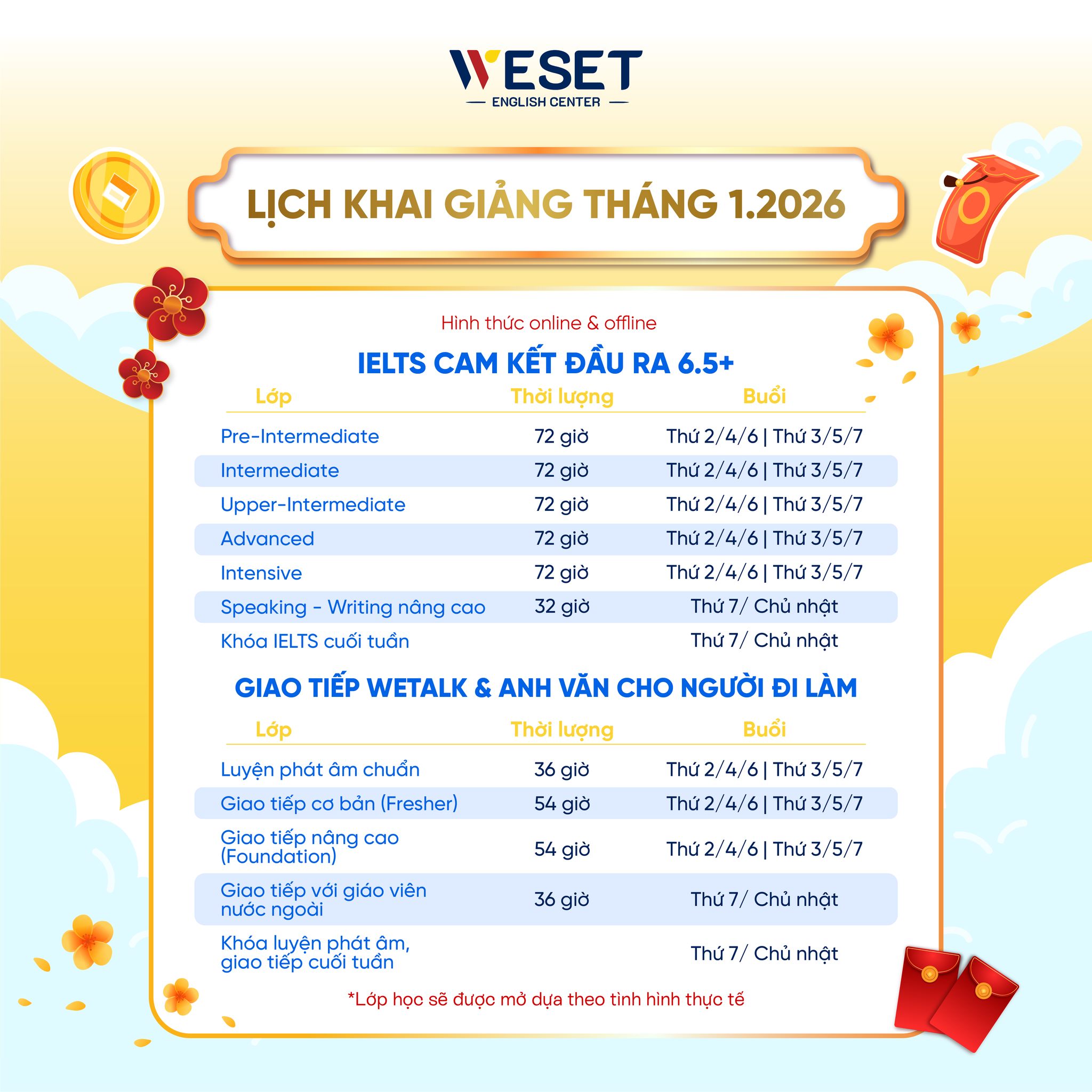Trang chủ Blog Bài thi IELTS mẫu IELTS Writing Environment Task 2: Hướng dẫn làm & Bài mẫu
IELTS Writing Environment Task 2: Hướng dẫn làm & Bài mẫu
- Jonathan M. Pham
- Bài mẫu IELTS Sample Writing, Bài mẫu Task 2 IELTS Writing sample, Bài thi IELTS mẫu
MỤC LỤC
Trong thời buổi biến đổi khí hậu ngày nay, môi trường luôn nằm trong số những topic Writing Task 2 hot thường xuất hiện trong bài thi. Hôm nay, trở lại với series Sample Writing Task 2 của WESET, bạn đọc hãy cùng khám phá cách làm bài IELTS Writing Environment nhé!
Phân tích topic IELTS Writing Environment
Sau đây chúng ta sẽ cùng nghiên cứu một số subtopic thường gặp với chủ đề IELTS Writing Environmnet – kèm theo gợi ý brainstorm ý tưởng cho từng subtopic cụ thể.
-
Climate Change (Biến đổi khí hậu)
Thảo luận về nguyên nhân, ảnh hưởng và giải pháp liên quan đến sự nóng lên toàn cầu và biến đổi khí hậu.
- Causes: Greenhouse gas emissions from human activities, such as burning fossil fuels (coal, oil, and gas), deforestation, and industrial processes.
- Problems: Rising global temperatures, melting ice caps, sea level rise, more frequent and severe weather events (hurricanes, droughts, floods), disruptions to ecosystems and agriculture.
- Solutions: Transition to renewable energy sources, reduce emissions through energy efficiency and conservation, afforestation and reforestation, international cooperation on emissions reduction.
-
Pollution (Ô nhiễm môi trường)
Nghiên cứu về các loại ô nhiễm khác nhau như: ô nhiễm không khí, ô nhiễm nước và ô nhiễm đất… tác động của chúng đến môi trường & các giải pháp khả thi.
- Causes: Industrial emissions, vehicle exhaust, agricultural runoff, improper waste disposal, plastic waste, and chemical pollutants.
- Problems: Degraded air and water quality, health issues (respiratory problems, waterborne diseases), loss of biodiversity, damage to ecosystems.
- Solutions: Implement stricter emission standards, promote recycling and proper waste disposal, encourage use of cleaner technologies, raise public awareness about pollution.
-
Conservation (Bảo tồn)
Khám phá tầm quan trọng của việc bảo tồn tài nguyên thiên nhiên, động vật hoang dã và hệ sinh thái, đồng thời thảo luận về các chiến lược quản lý tài nguyên bền vững.
- Causes: Human activities leading to habitat destruction, overexploitation of resources, urbanization, and pollution.
- Problems: Loss of biodiversity, extinction of species, disruption of ecosystems, imbalanced food chains.
- Solutions: Establish protected areas and wildlife reserves, enforce hunting and fishing regulations, promote sustainable land and resource management, support conservation research and education.
-
Renewable Energy (Năng lượng tái tạo)
Xem xét các nguồn năng lượng tái tạo (mặt trời, gió, thủy điện, v.v…), lợi ích, thách thức và vai trò tiềm năng của chúng trong việc giảm tác động tiêu cực đến môi trường.
- Causes: Dependence on fossil fuels, finite nature of fossil fuel reserves, environmental concerns related to fossil fuel extraction and combustion.
- Problems: Greenhouse gas emissions, air pollution, resource depletion, vulnerability to oil price fluctuations.
- Solutions: Increase adoption of solar, wind, hydro, and geothermal energy sources, invest in research and development of renewable technologies, provide incentives for renewable energy use.
-
Deforestation (Phá rừng)
Thảo luận về hậu quả của việc phá rừng, tác động đối với đa dạng sinh học và khí hậu, cùng các biện pháp phòng chống.
- Causes: Clearing land for agriculture, logging for timber and paper products, expansion of urban areas, mining activities.
- Problems: Loss of habitat for wildlife, disruption of water cycles, soil erosion, release of carbon dioxide into the atmosphere.
- Solutions: Implement sustainable logging practices, promote reforestation and afforestation, enforce laws against illegal logging, support community-based conservation efforts.
-
Waste Management (Quản lý chất thải)
Nghiên cứu các vấn đề liên quan đến việc tạo ra chất thải, tái chế, giảm thiểu chất thải và các phương pháp xử lý thích hợp.
- Causes: Increased consumption, improper waste disposal practices, lack of recycling infrastructure, overuse of single-use plastics.
- Problems: Landfill overflow, marine pollution, health hazards for waste workers, resource wastage.
- Solutions: Promote recycling and composting, reduce single-use plastics, implement proper waste segregation, invest in waste-to-energy technologies.
-
Wildlife Protection (Bảo vệ động vật hoang dã)
Thảo luận về tầm quan trọng của việc bảo tồn và bảo vệ các loài có nguy cơ tuyệt chủng và môi trường sống của chúng.
- Causes: Habitat destruction, poaching, illegal wildlife trade, pollution, climate change.
- Problems: Species extinction, imbalanced ecosystems, loss of biodiversity, disruption of food chains.
- Solutions: Strengthen anti-poaching efforts, enforce wildlife protection laws, support conservation organizations, raise awareness about the importance of wildlife.
-
Environmental Policies (Chính sách môi trường)
Phân tích các chính sách của chính phủ và các thỏa thuận quốc tế nhằm giải quyết các thách thức về môi trường và thúc đẩy phát triển bền vững.
- Causes: Growing environmental concerns, public demand for action, scientific research on environmental impacts.
- Problems: Inconsistent or weak policies, lack of enforcement, conflicts between economic growth and environmental protection.
- Solutions: Develop and enforce robust environmental regulations, promote international cooperation on environmental issues, provide incentives for sustainable practices.
-
Urbanization and the Environment (Đô thị hóa và Môi trường)
Xem xét sự phát triển đô thị tác động đến môi trường như thế nào, bao gồm các vấn đề như mở rộng đô thị, ô nhiễm và phát triển cơ sở hạ tầng.
- Causes: Population growth, rural-to-urban migration, industrialization, infrastructure development.
- Problems: Air and water pollution, deforestation, loss of agricultural land, increased energy consumption.
- Solutions: Plan sustainable urban development, invest in public transportation, implement green building practices, protect green spaces.
-
Water Scarcity (Khan hiếm nước)
Thảo luận về vấn đề khan hiếm nước đang gia tăng, nguyên nhân, tác động và các giải pháp tiềm năng.
- Causes: Over-extraction of groundwater, pollution of water sources, climate change affecting precipitation patterns.
- Problems: Reduced access to clean drinking water, conflicts over water resources, threats to agriculture and food security.
- Solutions: Efficient water use and management, promote water-saving technologies, watershed protection, desalination and water recycling.
-
Environmental Education (Giáo dục về Môi trường)
Khám phá vai trò của giáo dục trong việc nâng cao nhận thức về các vấn đề môi trường và thúc đẩy các hoạt động bền vững.
- Causes: Growing awareness of environmental issues, recognition of the need for sustainable practices, advancements in education and communication.
- Problems: Lack of awareness about environmental problems, insufficient inclusion of environmental topics in curricula, resistance to change.
- Solutions: Incorporate environmental education into school curricula, raise public awareness through campaigns and media, promote lifelong learning about sustainability.
-
Plastic Pollution (Ô nhiễm nhựa)
Phân tích vấn đề ô nhiễm nhựa, tác động của nó đối với sinh vật biển và hệ sinh thái, đồng thời đưa ra các sáng kiến nhằm giảm thiểu rác thải nhựa.
- Causes: Excessive plastic production, improper waste management, single-use plastic consumption, lack of recycling infrastructure.
- Problems: Plastic accumulation in oceans and waterways, harm to marine life, microplastic pollution, ecosystem disruption.
- Solutions: Reduce plastic production and consumption, promote reusable alternatives, improve waste collection and recycling systems, encourage plastic-free initiatives.
-
Air Quality (Chất lượng không khí)
Thảo luận về các mối quan tâm liên quan đến chất lượng không khí, các nguồn gây ô nhiễm không khí và các biện pháp cải thiện chất lượng không khí ở các khu đô thị và khu công nghiệp.
- Causes: Emissions from vehicles, industrial activities, burning of fossil fuels, agricultural practices, indoor pollution.
- Problems: Respiratory illnesses, smog formation, acid rain, reduced visibility, negative impacts on ecosystems.
- Solutions: Implement stricter emissions standards, promote use of cleaner fuels and technologies, enhance public transportation, encourage green urban planning.
-
Biodiversity Loss (Suy giảm đa dạng sinh học)
Khám phá tầm quan trọng của đa dạng sinh học, các yếu tố góp phần làm mất đa dạng sinh học, và những nỗ lực để bảo vệ và phục hồi nó.
- Causes: Habitat destruction, pollution, climate change, overexploitation, invasive species.
- Problems: Imbalanced ecosystems, reduced resilience to environmental changes, loss of potential medical and scientific resources.
- Solutions: Protect and restore habitats, regulate hunting and fishing, establish protected areas, support conservation research and sustainable land use.
-
Sustainable Agriculture (Nông nghiệp bền vững)
Đánh giá các phương pháp canh tác bền vững, nông nghiệp hữu cơ và giảm tác động môi trường của sản xuất lương thực.
- Causes: Intensive farming practices, use of synthetic pesticides and fertilizers, monoculture, soil degradation.
- Problems: Soil erosion, water pollution, loss of biodiversity, reduced soil fertility, negative health impacts.
- Solutions: Adopt organic and regenerative farming practices, promote crop rotation and agroforestry, reduce pesticide use, support local and sustainable food systems.
Đề bài mẫu topic IELTS Writing Environment
Question: In many countries, the government is taking measures to encourage businesses and industries to reduce their environmental impact. To what extent do you agree or disagree with this approach? Provide reasons and examples to support your response.
Phân tích đề bài:
- Subtopic: Environmental Policies
- Dạng bài: Opinion/Agree or Disagree
- Main topic: Encourage businesses and industries to reduce their environmental impact
- Task: To what extent do you agree or disagree
Hướng dẫn lập dàn ý & các bước làm bài:
- Thesis statement: Agree – đồng ý với cách tiếp cận của chính phủ.
- Introduction:
Bắt đầu với phần giới thiệu chung về chủ đề tác động môi trường và các biện pháp của chính phủ. Trình bày luận điểm (thesis statement) của bạn một cách rõ ràng và chính xác.
- Body Paragraph 1: Government Intervention
Viết một câu chủ đề (topic sentence) giới thiệu lý do đầu tiên của bạn. Giải thích tại sao sự can thiệp của chính phủ là rất quan trọng trong việc khuyến khích các doanh nghiệp giảm tác động môi trường của họ. Cung cấp ví dụ, chẳng hạn như làm thế nào các tiêu chuẩn khí thải đã làm giảm ô nhiễm không khí một cách hiệu quả.
- Body Paragraph 2: Positive Impact on Industries
Trình bày lý do thứ hai của bạn với một câu chủ đề. Giải thích làm thế nào các quy định và khuyến khích có thể dẫn đến những thay đổi tích cực trong các ngành công nghiệp. Đưa ra một ví dụ, chẳng hạn như trợ cấp cho năng lượng tái tạo đã thúc đẩy đổi mới và tạo việc làm như thế nào.
- Body Paragraph 3: Successful Policies
Giới thiệu lý do thứ ba. Thảo luận về các chính sách thành công của chính phủ dẫn đến cải thiện môi trường. Đề cập đến các quốc gia hoặc khu vực cụ thể đã đạt được kết quả tích cực nhờ các biện pháp của chính phủ.
- Conclusion
Tóm tắt các điểm chính và trình bày lại luận điểm. Nhấn mạnh tầm quan trọng của các hành động của chính phủ trong việc đảm bảo một tương lai bền vững và quan điểm đồng ý với cách tiếp cận đó của bạn.
Bài mẫu IELTS Writing Environment Task 2 – Sample answer
Environmental conservation is a paramount concern in the modern world, and I wholeheartedly agree that governments should play a proactive role in encouraging businesses and industries to minimize their environmental footprint. This approach is crucial in addressing the pressing environmental challenges we face today.
To begin with, industries and businesses are major contributors to environmental degradation, emitting harmful pollutants and depleting natural resources. Without proper regulations and incentives, these entities might prioritize profit over environmental responsibility. Government intervention is essential to ensure that industries adhere to environmentally friendly practices. For instance, stringent emission standards enforced by governments have led to significant reductions in air pollution levels in various countries.
Moreover, governmental encouragement can drive innovation in sustainable technologies and practices. When industries are incentivized to adopt greener technologies, they are more likely to invest in research and development of cleaner production methods. In Germany, for instance, government subsidies for renewable energy sources have led to the growth of a thriving renewable energy sector, reducing the country’s dependence on fossil fuels.
However, some may argue that strict regulations could hinder economic growth and competitiveness. Nevertheless, it is crucial to recognize that a healthy environment is a prerequisite for sustainable economic development. In the long term, the costs of environmental degradation, such as health expenses and ecosystem restoration, can outweigh any short-term economic benefits.
In conclusion, I firmly believe that government intervention to encourage industries and businesses to reduce their environmental impact is not only necessary but also beneficial for our planet’s future. By promoting responsible practices and fostering innovation, governments can help mitigate environmental degradation and pave the way for a more sustainable and prosperous future.
Một số đề bài IELTS Writing Environment Task 2 khác
IELTS Writing Environment Task 2 – Sample 1
Question: Some people believe that the best way to address environmental problems is to raise the cost of fuel for cars and other vehicles. To what extent do you agree or disagree? Provide reasons and examples to support your response.
- Subtopic: Climate Change
- Dạng bài: Opinion/Agree or Disagree
Answer: In my view, I strongly agree that increasing the cost of fuel for vehicles is an effective strategy to tackle environmental issues, particularly climate change. This approach can lead to significant reductions in greenhouse gas emissions and encourage the adoption of more sustainable transportation alternatives.
Raising the cost of fuel serves as a deterrent to excessive car usage and encourages individuals to consider alternative modes of transportation, such as public transit, cycling, or carpooling. In European countries where fuel prices are high due to heavy taxation, people are more inclined to use public transport or adopt energy-efficient vehicles. As a result, these nations have lower carbon emissions per capita and are making notable progress in curbing climate change.
Furthermore, higher fuel prices can stimulate innovation in the automotive industry. As consumers demand more fuel-efficient vehicles, manufacturers are pushed to develop hybrid and electric cars, which are less harmful to the environment. The success of electric car companies like Tesla is a testament to the market’s responsiveness to changes in fuel prices.
However, some argue that such measures disproportionately affect low-income individuals who heavily rely on personal vehicles. While this concern is valid, governments can counterbalance this by investing in affordable public transportation options and providing incentives for eco-friendly vehicles.
In conclusion, raising the cost of fuel for vehicles is a practical and effective strategy to address environmental challenges, particularly in mitigating climate change. By encouraging sustainable transportation choices and fostering innovation, we can move closer to a more environmentally friendly future.
IELTS Writing Environment Task 2 – Sample 2
Question: Many people believe that the government should be solely responsible for solving environmental problems. To what extent do you agree or disagree? Provide reasons and examples to support your response.
- Subtopic: Environmental Responsibility and Solutions
- Dạng bài: Opinion/Agree or Disagree
Answer: While the government certainly plays a crucial role in addressing environmental problems, I firmly believe that the responsibility for solving these issues extends beyond governmental actions alone. Environmental conservation requires a collaborative effort involving governments, industries, communities, and individuals.
Governments have a significant role in setting and enforcing regulations that protect the environment. They can enact laws to limit pollution, encourage renewable energy adoption, and preserve natural habitats. However, relying solely on governments is insufficient. For instance, the success of recycling programs largely depends on the active participation of citizens, local businesses, and waste management companies.
Industries also bear substantial responsibility for reducing their environmental impact. When companies adopt eco-friendly practices, such as sustainable resource management and waste reduction, they contribute significantly to environmental preservation. For instance, the fashion industry’s shift towards sustainable materials and production methods has a direct positive impact on reducing pollution and resource depletion.
Moreover, individuals play a vital role by making conscious choices in their daily lives. Simple actions such as reducing water and energy consumption, minimizing plastic use, and supporting eco-friendly products collectively contribute to environmental well-being. In communities where citizens actively engage in conservation efforts, the overall impact is more substantial, complementing government initiatives.
In conclusion, while the government is a key player in solving environmental problems, the responsibility should be shared among governments, industries, communities, and individuals. Collaborative efforts that involve various stakeholders are essential to effectively address and overcome the complex challenges posed by environmental issues.
IELTS Writing Environment Task 2 – Sample 3
Question: Some people argue that economic growth should take precedence over environmental protection. To what extent do you agree or disagree with this viewpoint? Provide reasons and examples to support your response.
- Subtopic: Balancing Economic Growth and Environmental Protection
- Dạng bài: Opinion/Agree or Disagree
Answer: I fundamentally disagree with the notion that economic growth should be prioritized over environmental protection. While economic development is important for improving quality of life, it should not come at the expense of our planet’s health and long-term sustainability.
Firstly, the idea that economic growth and environmental protection are mutually exclusive is a fallacy. Sustainable economic growth can be achieved alongside robust environmental conservation efforts. For instance, the renewable energy sector has demonstrated that investments in green technologies can create jobs, stimulate innovation, and contribute to economic prosperity while simultaneously reducing carbon emissions.
Furthermore, the negative consequences of environmental degradation can outweigh the short-term economic gains. Pollution and resource depletion can lead to increased healthcare costs, reduced agricultural productivity, and irreversible damage to ecosystems. Ignoring environmental protection can result in long-term economic instability and jeopardize the well-being of future generations.
Countries that prioritize environmental protection often reap the benefits of enhanced resilience, improved air and water quality, and greater biodiversity. Costa Rica, for example, has shown that a focus on sustainable tourism and conservation has bolstered its economy while preserving its natural treasures.
In conclusion, the belief that economic growth should supersede environmental protection is misguided. Striking a balance between economic development and environmental stewardship is not only possible but also imperative for ensuring a sustainable and prosperous future for both current and future generations.
Đọc thêm: 5 dạng Writing Task 2
Từ vựng IELTS Writing Environment Task 2 Vocabulary
| English | Vietnamese |
|---|---|
| Environmental conservation | Bảo tồn môi trường |
| Greenhouse gas emissions | Phát thải khí nhà kính |
| Climate change | Biến đổi khí hậu |
| Emission standards | Tiêu chuẩn khí thải |
| Sustainable practices | Thực hành bền vững |
| Renewable energy sources | Nguồn năng lượng tái tạo |
| Deforestation | Phá rừng |
| Biodiversity loss | Sự mất đa dạng sinh học |
| Pollution | Ô nhiễm |
| Waste management | Quản lý chất thải |
| Environmental policies | Chính sách môi trường |
| Public transportation | Giao thông công cộng |
| Energy-efficient vehicles | Xe tiết kiệm năng lượng |
| Eco-friendly products | Sản phẩm thân thiện với môi trường |
| Sustainable economic growth | Tăng trưởng kinh tế bền vững |
| Carbon emissions | Phát thải carbon |
| Environmental degradation | Sự suy thoái môi trường |
| Resource depletion | Cạn kiệt tài nguyên |
| Conservation efforts | Các nỗ lực bảo tồn |
| Plastic pollution | Ô nhiễm nhựa |
| Renewable energy sector | Lĩnh vực năng lượng tái tạo |
| Economic prosperity | Thịnh vượng kinh tế |
| Sustainability | Bền vững |
| Environmental stewardship | Sự quản lý chặt chẽ môi trường |
| Ecosystem disruption | Sự đảo lộn hệ sinh thái |
| Air and water quality | Chất lượng không khí và nước |
| Natural habitats | Môi trường sống tự nhiên |
| Environmental challenges | Thách thức môi trường |
| Green technologies | Công nghệ xanh |
| Eco-friendly practices | Thực hành thân thiện với môi trường |
| Resource management | Quản lý tài nguyên |
| Waste reduction | Giảm lượng chất thải |
| Carbon footprint | Dấu chân carbon |
| Conservation research | Nghiên cứu bảo tồn |
| Sustainability initiatives | Các sáng kiến bền vững |
| Renewable energy adoption | Sự áp dụng năng lượng tái tạo |
| Plastic-free initiatives | Các sáng kiến không sử dụng nhựa |
| Environmental well-being | Sự thịnh vượng của môi trường |
Lời kết
Trên đây là tổng hợp hướng dẫn làm bài, đề thi, gợi ý trả lời mẫu & từ vựng topic IELTS Writing Environment Task 2. Hãy thường xuyên luyện tập để thành thạo hơn mỗi ngày – cũng như đăng ký nhận tin và xem qua các khóa học IELTS của WESET để nâng cao năng lực và band điểm của chính mình bạn nhé!
Tham khảo các bài mẫu Sample Writing theo chủ đề khác:






